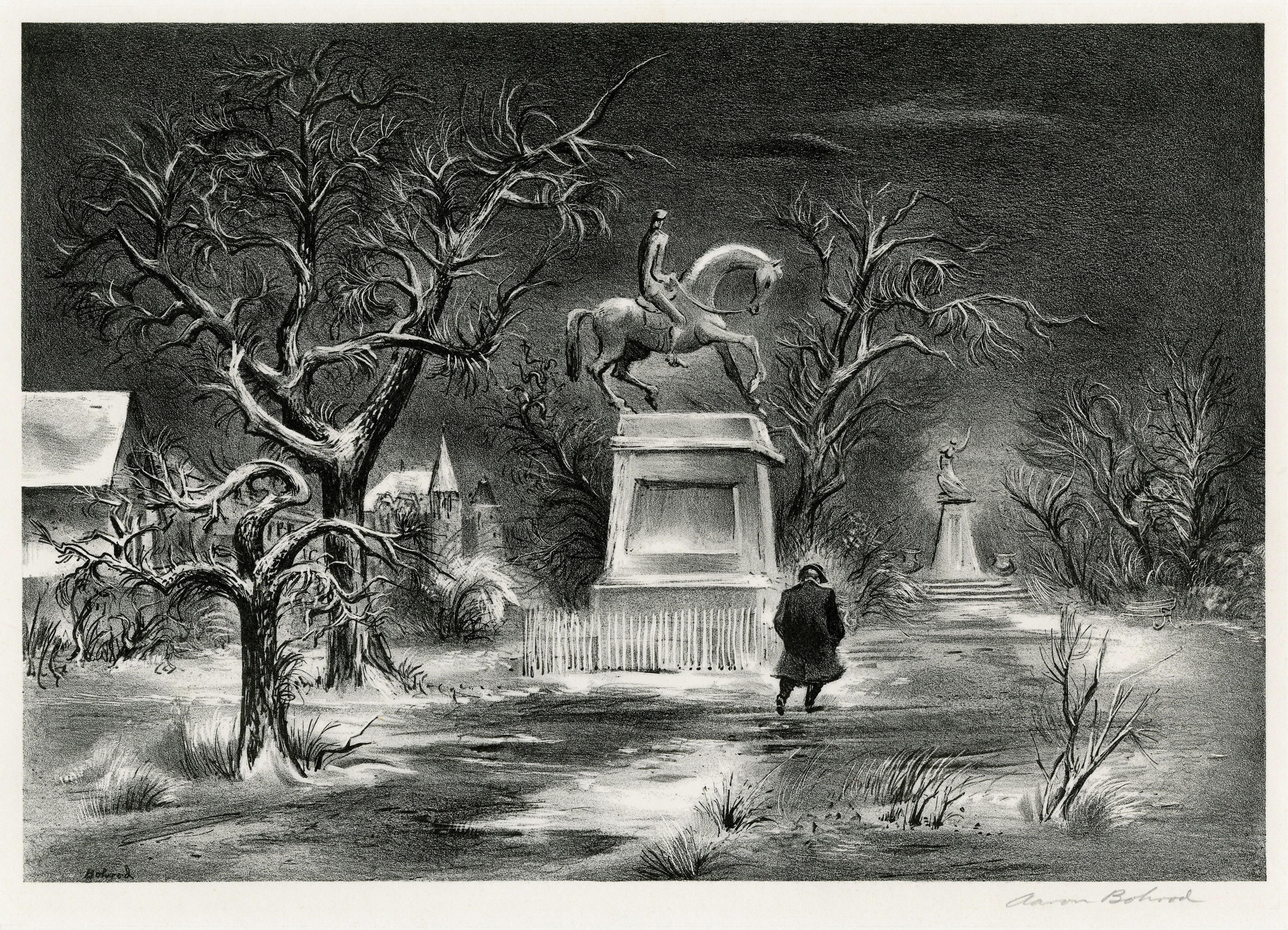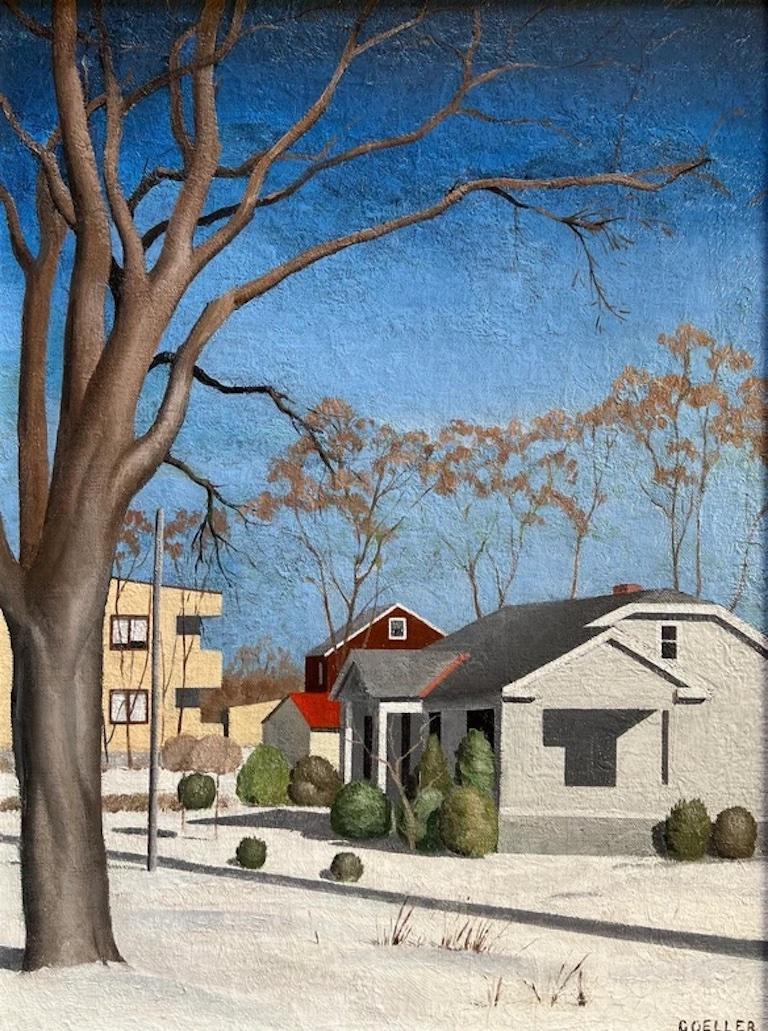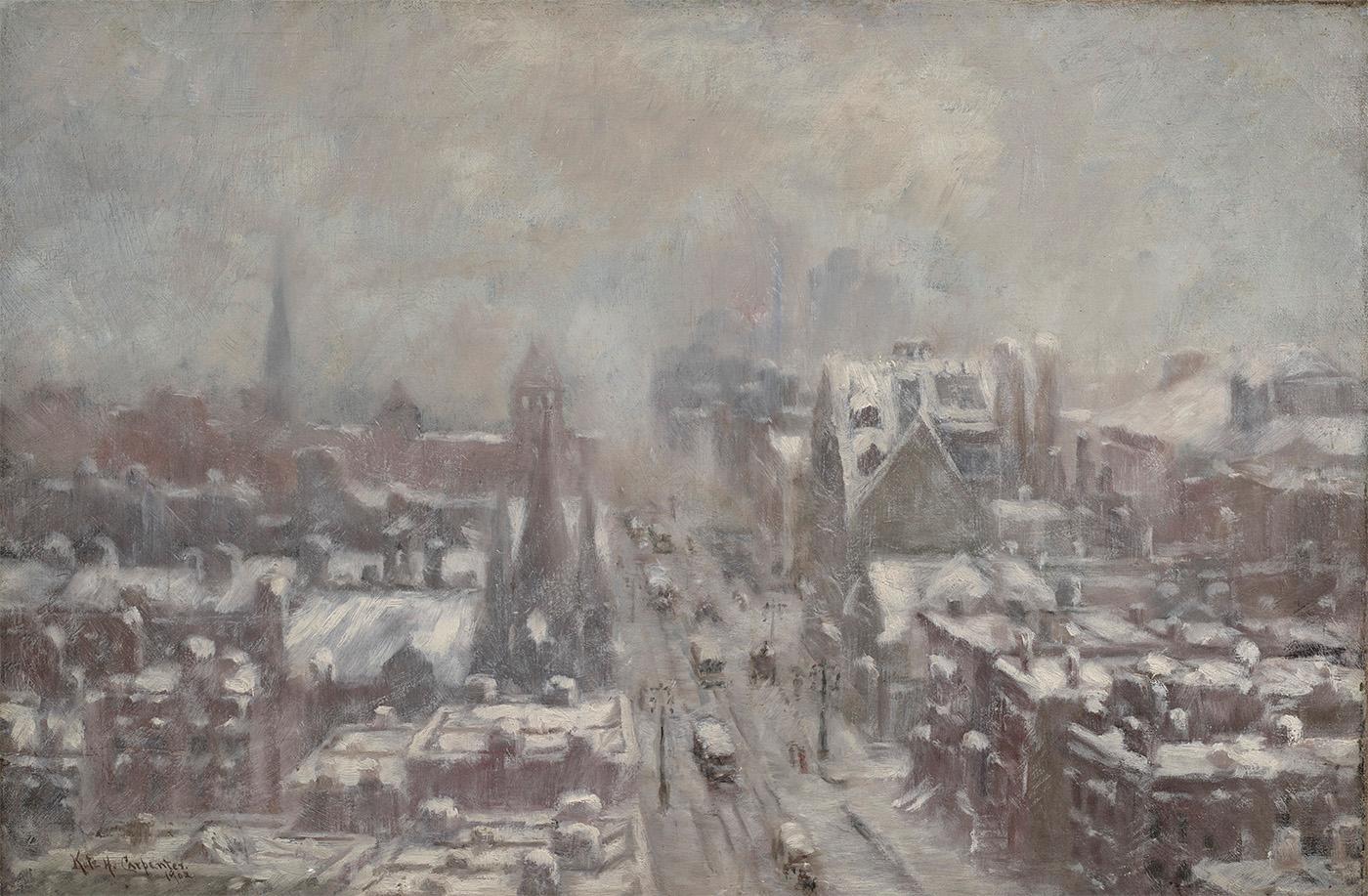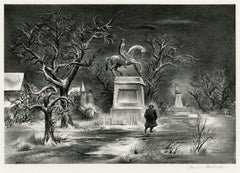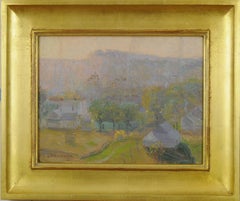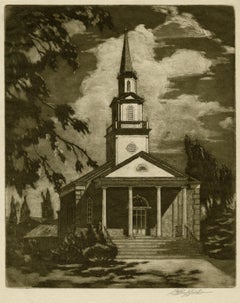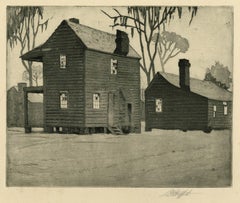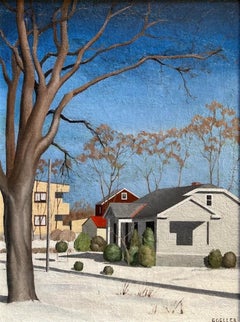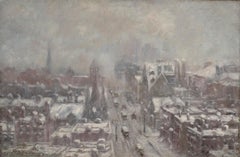Want more images or videos?
Request additional images or videos from the seller
1 of 7
Louis Oscar GriffithNashville in Winterc. 1928
c. 1928
$600
£453.18
€523.75
CA$841.59
A$936.07
CHF 489.92
MX$11,416.92
NOK 6,155.99
SEK 5,790.50
DKK 3,909.27
About the Item
Nashville in Winter
Etching, c. 1928
Signed in pencil lower right (see photo)
Very small edition
A rare image of early Nashville, Indiana
Excellent impression with plate tone in the sky
First state before the aquatint depicting a winter nocturne with fall snow
Printed on a fine laid paper with a Crown & Shield watermark
Provenance: Estate of the artist
By decent
Louis Oscar Griffith
(1875-1956)
Born in Greencastle, Indiana, Griffith grew up in Dallas, Texas where Texas artist and teacher Charles Franklin Reaugh recognized young “Griff’s” artistic talent. At age 18, Griffith moved to St. Louis where he attended the St. Louis School of Fine Arts.
In 1895, he moved to Chicago where he worked making color prints for the firm Barnes and Crosby. He attended the Art Institute of Chicago and during a brief stay in New York, the National Academy of Design. A successful commercial artist with a studio in the Chicago Loop, Griffith was a member and president of the Chicago Palette and Chisel Club.
He made his first trip to Brown County, Indiana in 1908, intrigued by reports of beautiful scenery by other Chicago-area artists such as Adolph Shultz and woodblock print-maker Gustave Baumann.
Griffith’s first exhibition was in 1903 at the Art Institute of Chicago, which by 1824 exhibited more than 60 of his works. He showed almost 70 works at the annual Hossier Salon Exhibition.
He won a bronze medal at the Panama-Pacific International Exposition in San Francisco in 1915; in 1921, he was a gold medalist at the Palette and Chisel Club; he won the Daughters of Indiana prize in 1925. The Chicago Society of Etchers recognized his works in 1949 and 1953; an oil, A Tranquil Afternoon, was awarded the Davis Wild Flower and Landscape prize in San Antonio, Texas.
The Smithsonian Institution in Washington mounted a special exhibit of Griffith’s prints in 1945. He also exhibited at the 1921 show of the Pennsylvania Academy of Fine Arts; the 1926 Sesquicentennial Exposition in Philadelphia; the 1927 second International Exhibition of Modern Engravings in Florence, Italy; the Canadian National Exposition; National Academy of Design in 1943; and the Library of Congress, also in 1943.
- Creator:Louis Oscar Griffith (1875-1956, American)
- Creation Year:c. 1928
- Dimensions:Height: 6 in (15.24 cm)Width: 8 in (20.32 cm)
- Medium:
- Movement & Style:
- Period:
- Condition:
- Gallery Location:Fairlawn, OH
- Reference Number:Seller: FA113871stDibs: LU14014530872
About the Seller
5.0
Recognized Seller
These prestigious sellers are industry leaders and represent the highest echelon for item quality and design.
Gold Seller
Premium sellers maintaining a 4.3+ rating and 24-hour response times
Established in 1978
1stDibs seller since 2013
808 sales on 1stDibs
Typical response time: <1 hour
Associations
International Fine Print Dealers Association
- ShippingRetrieving quote...Shipping from: Fairlawn, OH
- Return Policy
Authenticity Guarantee
In the unlikely event there’s an issue with an item’s authenticity, contact us within 1 year for a full refund. DetailsMoney-Back Guarantee
If your item is not as described, is damaged in transit, or does not arrive, contact us within 7 days for a full refund. Details24-Hour Cancellation
You have a 24-hour grace period in which to reconsider your purchase, with no questions asked.Vetted Professional Sellers
Our world-class sellers must adhere to strict standards for service and quality, maintaining the integrity of our listings.Price-Match Guarantee
If you find that a seller listed the same item for a lower price elsewhere, we’ll match it.Trusted Global Delivery
Our best-in-class carrier network provides specialized shipping options worldwide, including custom delivery.More From This Seller
View AllCity Park, Winter
By Aaron Bohrod
Located in Fairlawn, OH
City Park, Winter
Lithograph, c. 1947
Signed in pencil lower right (see photo)
Published by Associated American Artists
Printed by George C. Miller, New York
Edition: c. 250
In the Bohrod papers at Syracuse University, the artist states that it is a view of Pittsburgh. It depicts the George Washington Monument in Allegheny Commons Park, dedicated in 1891. The sculptor f the monument is Edward Ludwig Albert Pausch (1856-1931).
Condition: Excellent
Image size: 9 1/4 x 13 7/16 inches
Frame size: 19 x 23 inches
Provenance: Estate of Adolf Dehn
Reference: AAA Index No. 848
Aaron Bohrod (21 November 1907 – 3 April 1992) was an American artist best known for his trompe-l'œil still-life paintings.
Education
Bohrod was born in Chicago in 1907, the son of an emigree Bessarabian-Jewish grocer. Bohrod studied at the School of the Art Institute of Chicago and the Art Students League of New York between 1926 and 1930. While at the Art Students League, Bohrod was influenced by John Sloan and chose themes that involved his own surroundings.
Career
He returned to Chicago in 1930 where he painted views of the city and its working class. He eventually earned Guggenheim Fellowships which permitted him to travel throughout the country, painting and recording the American scene. His early work won him widespread praise as an important social realist and regional painter and printmaker and his work was marketed through Associated American Artists in New York. Bohrod completed three commissioned murals for the Treasury Departments Section of Fine Arts in Illinois; Vandalia in 1935, Galesburg in 1938 and Clinton in 1939. During World War II, Bohrod worked as an artist; first in the Pacific for the United States Army Corps of Engineers' Army War Art Unit...
Category
1940s American Realist Landscape Prints
Materials
Lithograph
Nashville at Sunrise
By Louis Oscar Griffith
Located in Fairlawn, OH
Nashville at Sunrise
Oil on canvas, mounted to archival resin board
Signed by the artist lower left
Provenance: Estate of the artist
By decent
A gorgeous Indiana Impressionist oil painting, done "plein air" (on location, outdoors)
Born in Greencastle, Indiana, Griffith grew up in Dallas, Texas where Texas artist and teacher Charles Franklin Reaugh recognized young “Griff’s” artistic talent. At age 18, Griffith moved to St. Louis where he attended the St. Louis School of Fine Arts.
In 1895, he moved to Chicago where he worked making color prints for the firm Barnes and Crosby. He attended the Art Institute of Chicago and during a brief stay in New York, the National Academy of Design. A successful commercial artist with a studio in the Chicago Loop, Griffith was a member and president of the Chicago Palette and Chisel Club.
He made his first trip to Brown County...
Category
1920s Landscape Paintings
Materials
Oil
The Great Church, Nashville
By Louis Oscar Griffith
Located in Fairlawn, OH
The Great Church, Nashville
Etching & aquatint, c. 1936
Signed in pencil lower right
A very rare trial proof
Annotated "2" lower left corner recto
Three total impressions in the esta...
Category
1930s American Realist Landscape Prints
Materials
Etching
Desolation, S.C. or Deserted Cabins, Beauford, S.C.
By Louis Oscar Griffith
Located in Fairlawn, OH
Desolation, S.C. or Deserted Cabins, Beauford, S.C.
Etching & Aquatint, c. 1930
Signed by the artist in pencil lower right (see photo)
Annotated "Trial Proof" in pencil lower left corner of sheet
Provenance: Estate of the artist
By decent
Note: An impression of this image is in the collection of the Greenville County Museum of Art, Greenville, South Carolina
Condition: Excellent
Plate/Image size: 8 x 9 3/4 inches
Sheet size: 12 7/8 x 15 inches
Louis Oscar Griffith
(1875-1956)
Born in Greencastle, Indiana, Griffith grew up in Dallas, Texas where Texas artist and teacher Charles Franklin Reaugh recognized young “Griff’s” artistic talent. At age 18, Griffith moved to St. Louis where he attended the St. Louis School of Fine Arts.
In 1895, he moved to Chicago where he worked making color prints for the firm Barnes and Crosby. He attended the Art Institute of Chicago and during a brief stay in New York, the National Academy of Design. A successful commercial artist with a studio in the Chicago Loop...
Category
1930s American Impressionist Landscape Prints
Materials
Aquatint
Lobsterman's Cove, Winter Harbor, Maine
By Stow Wengenroth
Located in Fairlawn, OH
Lobsterman's Cove, Winter Harbor, Maine
Lithograph, 1941
Signed in pencil lower right (see photo)
Edition 50
Impressions are in the collection of the Pennsylvania Academy of the Fine...
Category
1940s American Realist Landscape Prints
Materials
Lithograph
Preliminary Drawing for the color aquatint "New Orleans, Street Gossip"
By Louis Oscar Griffith
Located in Fairlawn, OH
Preliminary Drawing for the color aquatint "New Orlaens, Street Gossip"
Signed by the artist in pencil lower left
Graphite on tracing paper, 1916-1917
An impr...
Category
1910s American Impressionist Landscape Drawings and Watercolors
Materials
Graphite
You May Also Like
Winter Tracery (Milford Connecticut)
Located in San Francisco, CA
This artwork titled 'Winter Tracery (Milford Connecticut)" is an original drypoint etching by noted American artist Philip Kappel, 1901-1981. It is hand signed and titled in pencil by the artist. The plate mark (Image) size is 9 x 12 inches, framed size is 17.25 x 21.25 inches. Custom framed in a wooden light grey frame, with light grey matting and black color fillet. It is in excellent condition.
About the artist:
Philip Kappel — painter, illustrator, printer, writer, and lecturer — was born on February 10, 1901 in Hartford, CT and died in 1981. Kappel is best remembered for his landscapes, portraits, figures, marine, lithography, and etching. He held a teaching position with H. B. Snell, Boothbay, ME Studios, 1923 and 1924. His addresses in 1929 were 500 Fifth Avenue in New York City and, for the summer, care of Philip Little, 10 Chestnut Street, Salem, MA; and in 1935, Sarasota, FL.
Kappel was a pupil of the Pratt Institute Art School in Brooklyn, NY and Philip Little (1857-1942) and held memberships with the North Shore Artists Association in Gloucester, MA; the Marblehead...
Category
Mid-20th Century American Realist Figurative Prints
Materials
Drypoint, Etching
Suburb (in Winter)
Located in Los Angeles, CA
This painting is part of our exhibition Charles Goeller: A Wistful Loneliness.
Oil on canvas, 20 x 15 inches, Signed lower right
Exhibited:
1) Portrai...
Category
1940s American Modern Landscape Paintings
Materials
Oil
Winter Landscape
Located in San Francisco, CA
This artwork "Winter Landscape" c.1960 is a watercolor on paper by artist John E. Detore, 1902-1975. It is signed at the lower right corner by the artist. The image size is 13.5 x 19.5 inches, the framed size is 22.75 x 28.75 inches. Custom framed in original oak white wash frame, with off white matting. It is in excellent condition.
About the artist:
A native of Syracuse, John E. De Tore was born in 1902.
DeTore enjoyed painting continuously since the age of 8. Although he became an engineer with the Niagara Mohawk Power corporation he carried on elective training in the required branches of art.
He took seriously to the watercolor medium from 1940 and by 1955 he was well known for his decisively composed watercolor landscapes and their rich, deep chromatics - earning him acknowledgment in the American Artist Magazine November 1961 issue.
Besides teaching art at Syracuse Museum John DeTore...
Category
Mid-20th Century American Impressionist Landscape Drawings and Watercolors
Materials
Watercolor
Winter
Located in New York, NY
Signed and dated lower left: Kate H. Carpenter. / 1902
Category
20th Century American Impressionist Landscape Paintings
Materials
Canvas, Oil
Bucks County Winter Landscape
By Paul Bernard King
Located in Milford, NH
A wonderful winter village landscape in Bucks County by painted by American artist Paul Bernard King (1867-1947). King was born in Buffalo, New York, and ...
Category
Early 20th Century American Impressionist Landscape Paintings
Materials
Canvas, Oil
Winter in New England
Located in North Clarendon, VT
Stunning, ethereal winter scene by American Impressionist master Frederick Usher de Voll. His classic violet hues, beautiful brushwork and the crisp muted silence of a snowy winter d...
Category
1920s American Impressionist Landscape Paintings
Materials
Oil
More Ways To Browse
Hendrik Adriaan Van Rheede Tot Drakenstein
John Stobart Lithograph
Jorge Perez
Lahaina Maui
Leo Kuschel
Nelson Dawson
Otto Bacher Etchings
Peter Max Brown Lady
Peter Max Sunrise
Peter Max Two Sages
Queensboro Bridge
Tony Bennett Lithographs
Bernard Cathelin On Sale
Eyvind Earle Serigraph
Frank Licsko On Sale
Gonville Caius
Guy Maccoy
Jules Cavailles On Sale
